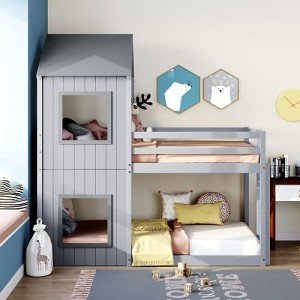Bunk beds have long been a popular choice among parents seeking to enhance space in their children's bedrooms. With advantages that go beyond their compact style, bunk beds use a fun and functional sleeping arrangement while motivating sibling bonding and fostering imagination. In this extensive guide, we explore numerous aspects of bunk beds for kids, consisting of security considerations, different styles offered, and suggestions for choosing the best one for your household.
Bunk beds are created to stack one bed on top of another, using vertical space to develop more room for play and storage. They are especially beneficial for families with numerous children or limited bedroom space. Furthermore, they provide a daring sleeping environment that kids frequently take pleasure in.
When choosing a bunk bed for kids, security ought to be the leading priority. The following features are important for making sure a secure sleeping environment:
Bunk beds come in a variety of styles, enabling parents to pick one that matches their kid's space design while conference particular needs. Below are some popular designs:
| Bunk Bed Style | Description | Best For |
|---|---|---|
| Standard | Traditional design with two stacked beds | Standard bedroom setups |
| Loft Bed | Raised bed with usable space underneath | Homework or play areas |
| L-Shaped | Bunk beds set up in an L-shape | Corner spaces |
| Twin over Full | Twin bed on top, full bed below | Various age siblings |
| Triple Bunk | Three stacked beds | Big families or pajama parties |
When looking for the perfect bunk bed, think about the following elements to guarantee you make a notified decision:
Normally, children aged 6 and older ought to be able to safely oversleep the leading bunk, though you should constantly consider your child's maturity level.
It is not suggested for toddlers or extremely kids to oversleep the top bunk due to the threat of falling.
Examine the bed routinely for any signs of wear and tear, tightening up screws, and cleaning the bed mattress to ensure prolonged safety and resilience.
Numerous bunk beds are developed to be convertible, enabling you to separate the beds when needed. Check the producer's specs before purchasing.
Use under-bed drawers, racks, or lofted styles to create extra storage solutions in a space with a bunk bed.
Bunk beds offer a delightful mix of enjoyable, functionality, and space-saving energy, making them an ideal option for young families. By considering security functions, different styles, and useful factors such as space size and age appropriateness, parents can choose the perfect bunk bed for their child's requirements. With the ideal option, bunk beds can change a bed room into a wonderful space that motivates play, creativity, and bonding among siblings. Always keep in mind to prioritize safety and upkeep to maximize this unique sleeping plan.

No Data Found!
